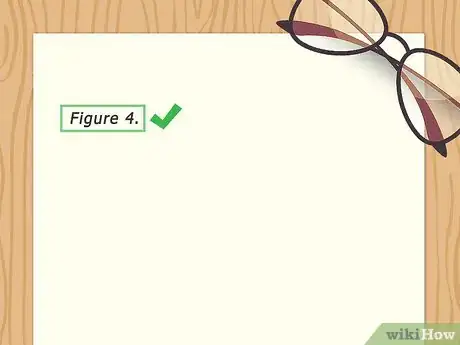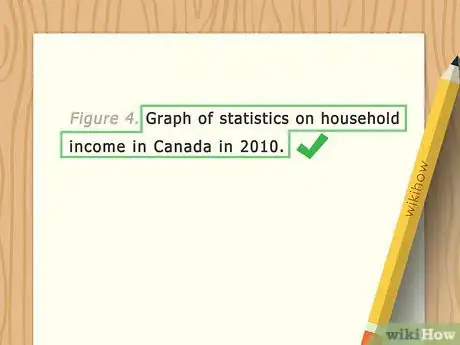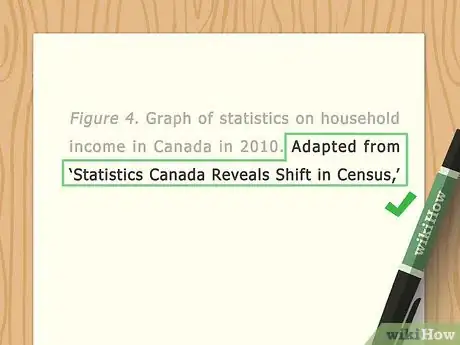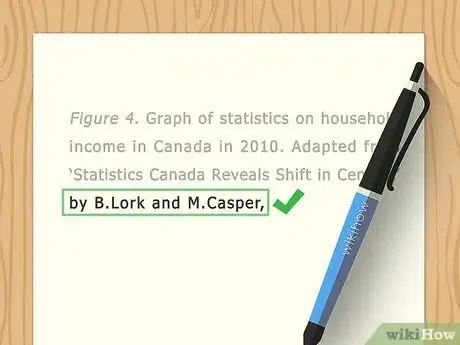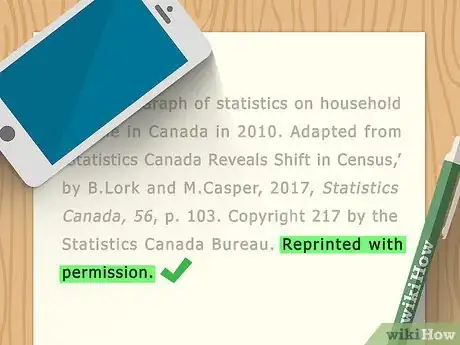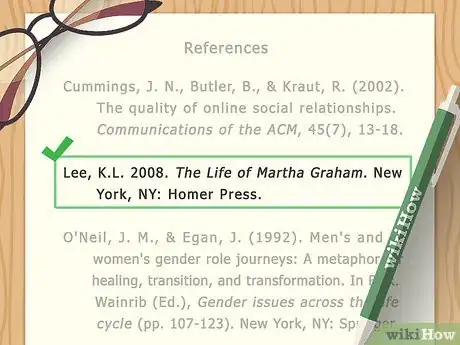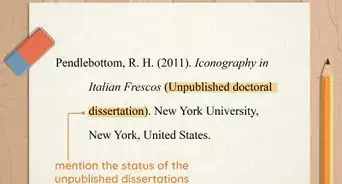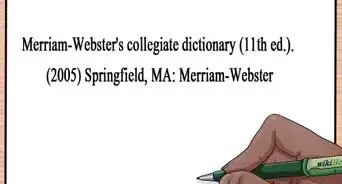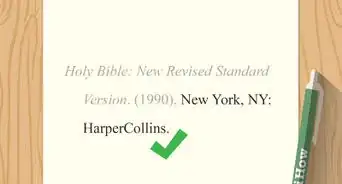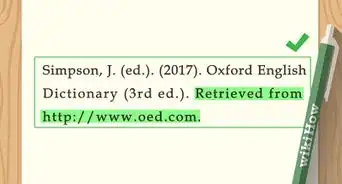This article was co-authored by wikiHow Staff. Our trained team of editors and researchers validate articles for accuracy and comprehensiveness. wikiHow's Content Management Team carefully monitors the work from our editorial staff to ensure that each article is backed by trusted research and meets our high quality standards.
There are 7 references cited in this article, which can be found at the bottom of the page.
This article has been viewed 181,164 times.
Learn more...
Figures like a chart, graph, or image are great sources when you want to support your ideas in an essay or paper. You may need to cite figures in APA for an essay or paper for a class. Whether you are citing a figure from a book, an article, or a website, you can create a citation and format it properly in APA in just a few simple steps.
Steps
Creating the Citation
-
1Begin with “Figure” and then the number of the figure in italics. The figure does not need a specific title. Instead, start with the word “Figure” and then the number of the figure based on where it is placed in the paper, going in chronological order.[1]
- For example, if the figure is the first figure to appear in the paper, you would start the citation with, “Figure 1.” If the figure is the fourth figure to appear in the paper, the citation would start with, “Figure 4.”
-
2Include a descriptive phrase about the figure. Give the reader a brief explanation that outlines what the figure is about or refers to. The phrase should summarize the information in the figure in a concise, clear way.[2]
- For example, if you are citing a graph with statistics, you may write, “Graph of statistics on household income in Canada in 2010.” Or if you are citing an image, you may write, “Black and white photograph of Martha Graham in the Vienna Performance Hall.”
Advertisement -
3Note the source or reference where you found the figure. Write, “Reprinted from” or “Adapted from,” followed by the title of the book, article, or website where you found the figure. Include the page number where you found the figure as well if you are citing a figure from a book.[3]
- For example, you may write in a citation for a book, “Reprinted from The Life of Martha Graham (p 84).”
- For a citation for an article, you may write, “Adapted from ‘Statistics Canada Reveals Shift in Census.’”
- If you are citing a figure from a website, you may write, “Reprinted from The Huffington Post.”
-
4Include the author’s first and second initial as well as their surname. Use the author’s first and second initial, if available, rather than the author’s full first name. Note their last name as well. If there are multiple authors, include them all, separating them with “and.”[4]
- For example, you may write, “...by K.L. Lee” or “...by B. Lork and M. Casper.”
-
5List the source. If the reference is a book, note the year the book was printed as well as the city and state of the publisher. Include the name of the publisher as well. For example, you may write, “2008, New York, NY: Homer Press” or “2010, New Haven, CT: Beehive Press.”[5]
- If you are using an article reference, include the year the article was published as well as the name of the journal and the number of the volume where the article appears in italics. List the page number where you found the figure in the article as well.
- For example, you may write, “2017, Statistics Canada, 56, p. 103” or “2002, Children Today, 14, p. 90.”
- If the reference is a website, note the year the figure was published on the website, if available. If it is not available, use “n.d.” for “no date.” Then, note, “Retrieved from” and the URL of the website.
- For example, you may write, “2008, Retrieved from http://www.statisticscanada.com” or “n.d., Retrieved from http://www.childrentoday.org.”
-
6Note the copyright information for the figure. Finish the citation by noting the copyright year and the name of the copyright holder for the figure. You should be able to find this information in the citation for the figure in the original source.[6]
- For example, you may write, “Copyright 217 by the Statistics Canada Bureau” or “Copyright 2012 by the Children Choice Organization.”
- If you cannot find copyright information for the figure, you can leave this information out.
-
7Review the completed citation. Once you have created the citation for the figure, look over it to ensure it contains all the necessary information.
- A complete citation for a figure from a book would be: “Figure 1. Black and white photograph of Martha Graham in the Vienna Performance Hall. Reprinted from The Life of Martha Graham (p 84), by K.L. Lee, 2008, New York, NY: Homer Press. Copyright 2008 by the Modern Dance School.”
- A complete citation for a figure from an article would be: “Figure 4. Graph of statistics on household income in Canada in 2010. Adapted from ‘Statistics Canada Reveals Shift in Census,’ by B.Lork and M.Casper, 2017, Statistics Canada, 56, p. 103. Copyright 217 by the Statistics Canada Bureau.”
- A complete citation for a figure from a website would be: “Figure 6. Drawing of a child playing with plastic toys. Reprinted from Children Today, n.d., Retrieved from https://www.childrentoday.org/. Copyright 2008 by Joan Lee.”
Formatting the Citation
-
1Place the citation underneath the figure and double-space it. The citation should always appear below the figure in your paper. This will ensure it identifies the figure clearly. You should also double-space it so it is easy to read.[7]
-
2Get permission to reprint the figure if you plan to publish your paper. If you’d like to publish your paper in a thesis, a journal, or a publication, you will need to get permission from the original copyright holder to reprint the figure. Then, note you obtained permission by placing “Reprinted with permission” at the end of the citation.[8]
- For example, you may write, “Figure 4. Graph of statistics on household income in Canada in 2010. Adapted from ‘Statistics Canada Reveals Shift in Census,’ by B.Lork and M.Casper, 2017, Statistics Canada, 56, p. 103. Copyright 217 by the Statistics Canada Bureau. Reprinted with permission.”
-
3Cite the source for the figure in the Reference List. Per APA guidelines, you must include a full bibliographic entry for the source for the figure at the end of your paper on the Reference List page. Double-space each entry in the Reference List and order them alphabetically. Follow APA format for the citation, making sure to include the title of the book, article, or website, the author, and the publishing information for the source.[9]
- For example, a citation in your Reference List for a book would be, "Lee, K.L. 2008. The Life of Martha Graham. New York, NY: Homer Press."
Community Q&A
-
QuestionI created my own figure but used the data from the text of a journal document. How is that cited in the caption?
 Community AnswerNote (italicized). Adapted from Work-title-in-italics, by author name. Retrieved Month-spelled-out Day-in-numerals, year, from Link. Make sure to include a title relevant to the source document.
Community AnswerNote (italicized). Adapted from Work-title-in-italics, by author name. Retrieved Month-spelled-out Day-in-numerals, year, from Link. Make sure to include a title relevant to the source document.
References
- ↑ https://www.lib.sfu.ca/help/cite-write/citation-style-guides/apa/tables-figures
- ↑ https://owl.purdue.edu/owl/research_and_citation/apa_style/apa_formatting_and_style_guide/apa_tables_and_figures.html
- ↑ https://guides.himmelfarb.gwu.edu/APA/image-figure
- ↑ https://aut.ac.nz.libguides.com/APA7th/figures
- ↑ https://guides.himmelfarb.gwu.edu/c.php?g=27779&p=170358
- ↑ https://www.lib.sfu.ca/help/cite-write/citation-style-guides/apa/tables-figures
- ↑ https://guides.himmelfarb.gwu.edu/c.php?g=27779&p=170358
- ↑ http://guides.lib.monash.edu/citing-referencing/apa-tables-figures
- ↑ https://ggu.libguides.com/c.php?g=106881&p=694051
About This Article
To cite a figure in APA, start by inserting the figure into your paper and placing the citation right below it. Begin each citation with “Figure” and the number of the figure in italics. Next, include a brief explanation of what the figure refers to, such as “Graph of statistics on household income in 2010.” Then, write “Reprinted from,” followed by the source and page number where you found the figure. Additionally, include the author’s first and last name, if applicable, and the copyright information. To learn how to cite the source of a figure in your paper’s reference list, keep reading.
